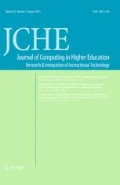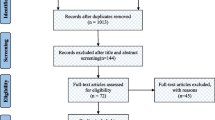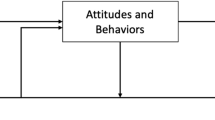Abstract
Gamification—the use of game elements in serious contexts, has been prevalent to enhance users’ motivation and engagement in difficult activities. In the literature related to higher education, the use of gamification has emerged as a new pedagogical approach in order to improve students’ learning behaviors. On the other hand, traditional education research suggested that working in groups can enhance students’ learning behaviors. However, no study has been found in the literature that investigates these two distinct concepts in education domain. Therefore, this research aims to explore the effect of different group sizes and gamification on students’ learning behaviors. For this purpose, the study has explored the comparison between gamification and traditional classroom settings on students’ learning behavior with different group sizes: individual, small group, and large group settings. Further, the comparison of students’ learning behaviors in gamification environment within different group settings over time has also been investigated in this research. The analysis suggests that different group sizes can have varying impacts on students’ perception of the course in gamification environment over time. Moreover, it was observed that group size only affects students’ interest, comparison, and discouragement in gamification environment, but does not affect their effort, perceived choice, perceived competence, tension, or motivation. Also, it was found that gamification does not affect the perceived competence of students in any of the group settings. These results can be useful in future decisions about the optimal classroom size, group activities, and group sizes in other activities in larger classrooms.





Similar content being viewed by others
References
Barata, G., Gama, S., Fonseca, M. J., & Gonçalves, D. (2013). Improving student creativity with gamification and virtual worlds. In Proceedings of the First International Conference on Gameful Design, Research, and Applications (pp. 95–98).
Barrio, C. M., Muñoz-Organero, M., & Soriano, J. S. (2015). Can gamification improve the benefits of student response systems in learning? An experimental study. IEEE Transactions on Emerging Topics in Computing, 4(3), 429–438.
Baylor, A. L., & Ritchie, D. (2002). What factors facilitate teacher skill, teacher morale, and perceived student learning in technology-using classrooms? Computers and Education, 39(4), 395–414.
Begel, A., & Simon, B. (2008). Struggles of new college graduates in their first software development job. In Proceedings of the 39th SIGCSE technical symposium on Computer science education (pp. 226–230).
Buunk, A. P., & Gibbons, F. X. (2006). Social comparison orientation: a new perspective on those who do and those who don’t compare with others. In S. Guimond (Ed.), Social comparison and social psychology: Understanding cognition, intergroup relations and culture (pp. 15–33). Cambridge: Cambridge University Press.
Christy, K. R., & Fox, J. (2014). Leaderboards in academic contexts: A test of stereotype threat and social comparison explanations for women’s math performance. Computers and Education, 78, 66–77. https://doi.org/10.1016/j.compedu.2014.05.005.
Cohen, R. J., Swerdlik, M. E., & Phillips, S. M. (1996). Psychological testing and assessment: An introduction to tests and measurement. California: Mayfield Publishing Co.
Crocker, B., Shaw, E. L., & Reed, B. (1990). Effects of encouragement or discouragement for using hands-on science activities upon teaching style. Journal of Elementary Science Education, 2(2), 10.
de Freitas, S., Gibson, D., Alvarez, V., Irving, L., Star, K., Charleer, S., & Verbert, K. (2017, April). How to use gamified dashboards and learning analytics for providing immediate student feedback and performance tracking in higher education. In Proceedings of the 26th international conference on world wide web companion (pp. 429–434).
Dennis, A. R., Valacich, J. S., & Nunamaker, J. F. (1990). An experimental investigation of the effects of group size in an electronic meeting environment. IEEE Transactions on Systems, Man, and Cybernetics, 20(5), 1049–1057.
Duvall, S., Hutchings, D. R., & Duvall, R. C. (2018, February). Scrumage: A method for incorporating multiple, simultaneous pedagogical styles in the classroom. In Proceedings of the 49th ACM technical symposium on computer science education (pp. 928–933).
Festinger, L. (1954). A theory of social comparison processes. Human relations, 7(2), 117–140. https://doi.org/10.1177/001872675400700202.
Flasch, P., Taylor, D., Clauber, R. N., & Robinson, E., III. (2017). Examining students’ self-perceived competence and comfort in an experiential play therapy counseling course: A single group pretest–posttest investigation. International Journal for the Scholarship of Teaching and Learning, 11(1), n1.
Gil, P. (2017). Short project-based learning with MATLAB applications to support the learning of video-image processing. Journal of Science Education and Technology, 26(5), 508–518.
González-Soltero, R., Learte, A. I. R., Sánchez, A. M., & Gal, B. (2017). Work station learning activities: a flexible and scalable instrument for integrating across basic subjects in biomedical education. BMC Medical Education, 17(1), 1–8.
Gordon, L. V., & Durea, M. A. (1948). The effect of discouragement on the revised Stanford–Binet scale. The Pedagogical Seminary and Journal of Genetic Psychology, 73(2), 201–207.
Halloluwa, T., Vyas, D., Usoof, H., & Hewagamage, K. P. (2018). Gamification for development: A case of collaborative learning in Sri Lankan primary schools. Personal and Ubiquitous Computing, 22(2), 391–407.
Hammar, C. E. (2014). Group work as an incentive for learning–students’ experiences of group work. Frontiers in Psychology, 5, 558.
Hanus, M. D., & Fox, J. (2015). Assessing the effects of gamification in the classroom: A longitudinal study on intrinsic motivation, social comparison, satisfaction, effort, and academic performance. Computers and Education, 80, 152–161.
Hedegard, J. M. (1981). The course perceptions questionnaire: Development and some pilot research findings. Law and Social Inquiry, 6(2), 463–531.
Ioannou, I., & Kyza, E. A. (2017, October). The role of gamification in activating primary school students' intrinsic and extrinsic motivation at a museum. In Proceedings of the 16th world conference on mobile and contextual learning (pp. 1–4).
Hoffmann, T. (1999). The meanings of competency. Journal of European Industrial Training, 23(6), 275–286.
Johnson, D. W., & Johnson, R. T. (1987). Learning together and alone: Cooperative, competitive, and individualistic learning. Englewood Cliffs: Prentice-Hall Inc.
Kahneman, D., & Tversky, A. (1982). The psychology of preferences. Scientific American, 246(1), 160–173.
Karatassis, I. (2017, March). WebSAIL: Computer-based methods for enhancing web search literacy. In Proceedings of the 2017 conference on conference human information interaction and retrieval (pp. 403–405).
Koivisto, J., & Hamari, J. (2014). Demographic differences in perceived benefits from gamification. Computers in Human Behavior, 35, 179–188.
Kubischta, F. (2014). Engagement and Motivation: Questioning students on study-motivation, engagement and study strategies. Retrieved November 17, 2017 from https://www.semanticscholar.org/paper/Engagement-and-motivation-%3A-questioning-students-on-Kubischta/bdf97e7438c0aa5d7bbc1f29030db567adc8ee24#citing-papers.
Largent, D. L. (2016). Measuring and understanding team development by capturing self-assessed enthusiasm and skill levels. ACM Transactions on Computing Education (TOCE), 16(2), 1–27.
Lavallée, L., & Flint, F. (1996). The relationship of stress, competitive anxiety, mood state, and social support to athletic injury. Journal of Athletic Training, 31(4), 296.
Leftheriotis, I., Giannakos, M. N., & Jaccheri, L. (2017). Gamifying informal learning activities using interactive displays: An empirical investigation of students’ learning and engagement. Smart Learning Environments, 4(1), 2.
Li, C., Dong, Z., Untch, R. H., & Chasteen, M. (2013). Engaging computer science students through gamification in an online social network based collaborative learning environment. International Journal of Information and Education Technology, 3(1), 72–77.
Mah, D. K. (2016). Learning analytics and digital badges: Potential impact on student retention in higher education. Technology, Knowledge and Learning, 21(3), 285–305.
Manyama, M., Stafford, R., Mazyala, E., Lukanima, A., Magele, N., Kidenya, B. R., et al. (2016). Improving gross anatomy learning using reciprocal peer teaching. BMC Medical Education, 16(1), 95.
McAuley, E., Duncan, T., & Tammen, V. V. (1989). Psychometric properties of the intrinsic motivation inventory in a competitive sport setting: A confirmatory factor analysis. Research Quarterly for Exercise and Sport, 60(1), 48–58.
Naya, V. B., & Ibáñez, L. A. H. (2015). Evaluating user experience in joint activities between schools and museums in virtual worlds. Universal Access in the Information Society, 14(3), 389–398.
Pechenkina, E., Laurence, D., Oates, G., Eldridge, D., & Hunter, D. (2017). Using a gamified mobile app to increase student engagement, retention and academic achievement. International Journal of Educational Technology in Higher Education, 14(1), 1–12.
Renninger, K. A., Hidi, S., Krapp, A., & Renninger, A. (Eds.). (2014). The role of interest in learning and development. Hove: Psychology Press.
Ryan, R. M., & Deci, E. L. (2000). Intrinsic and extrinsic motivations: Classic definitions and new directions. Contemporary Educational Psychology, 25(1), 54–67.
Seaborn, K., & Fels, D. I. (2015). Gamification in theory and action: A survey. International Journal of Human-Computer Studies, 74, 14–31.
Shahid, A., Wilkinson, K., Marcu, S., & Shapiro, C. M. (eds.) (2012), STOP, THAT and One Hundred Other Sleep Scales, DOI https://doi.org/10.1007/978-1-4419-9893-4, Springer Science+Business Media, LLC, Springer, New York, NY
Simões, J., Redondo, R. D., & Vilas, A. F. (2013). A social gamification framework for a K-6 learning platform. Computers in Human Behavior, 29(2), 345–353.
Sprint, G., & Cook, D. (2015, March). Enhancing the CS1 student experience with gamification. In 2015 IEEE integrated STEM education conference (pp. 94–99). IEEE.
Valdez, A. C., Brell, J., Schaar, A. K., & Ziefle, M. (2017). The diversity of why: A meta-analytical study of usage motivation in enterprise social networks. Universal Access in the Information Society, 17(3), 549–566.
Vivian, R., Falkner, K., Falkner, N., & Tarmazdi, H. (2016). A method to analyze computer science students’ teamwork in online collaborative learning environments. ACM Transactions on Computing Education (TOCE), 16(2), 1–28.
Waite, W. M., Jackson, M. H., Diwan, A., & Leonardi, P. M. (2004, March). Student culture vs group work in computer science. In Proceedings of the 35th SIGCSE technical symposium on computer science education (pp. 12–16).
Webb, N. M., & Palincsar, A. S. (1996). Group processes in the classroom. In D. C. Berliner & R. C. Calfee (Eds.), Handbook of Educational Psychology (pp. 841–873). New York: Macmillan.
Wells, B. M., & Skowronski, J. J. (2012). Evidence of choking under pressure on the PGA tour. Basic and Applied Social Psychology, 34(2), 175–182.
Wiggins, B. L., Eddy, S. L., Wener-Fligner, L., Freisem, K., Grunspan, D. Z., Theobald, E. J., ... & Crowe, A. J. (2017). ASPECT: A survey to assess student perspective of engagement in an active-learning classroom. CBE—Life Sciences Education, 16(2), ar32.
Yin, H. (2018). What motivates Chinese undergraduates to engage in learning? Insights from a psychological approach to student engagement research. Higher Education, 76(5), 827–847.
Author information
Authors and Affiliations
Corresponding author
Additional information
Publisher's Note
Springer Nature remains neutral with regard to jurisdictional claims in published maps and institutional affiliations.
Electronic supplementary material
Below is the link to the electronic supplementary material.
Rights and permissions
About this article
Cite this article
Ahmad, A., Zeeshan, F., Marriam, R. et al. Does one size fit all? Investigating the effect of group size and gamification on learners’ behaviors in higher education. J Comput High Educ 33, 296–327 (2021). https://doi.org/10.1007/s12528-020-09266-8
Accepted:
Published:
Issue Date:
DOI: https://doi.org/10.1007/s12528-020-09266-8




